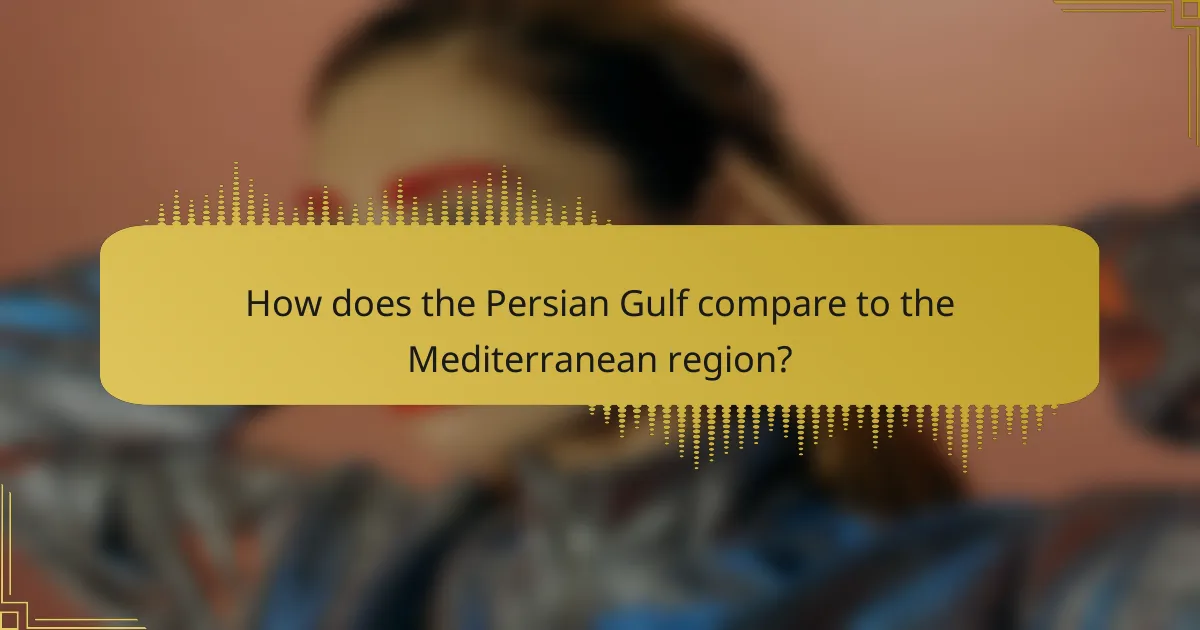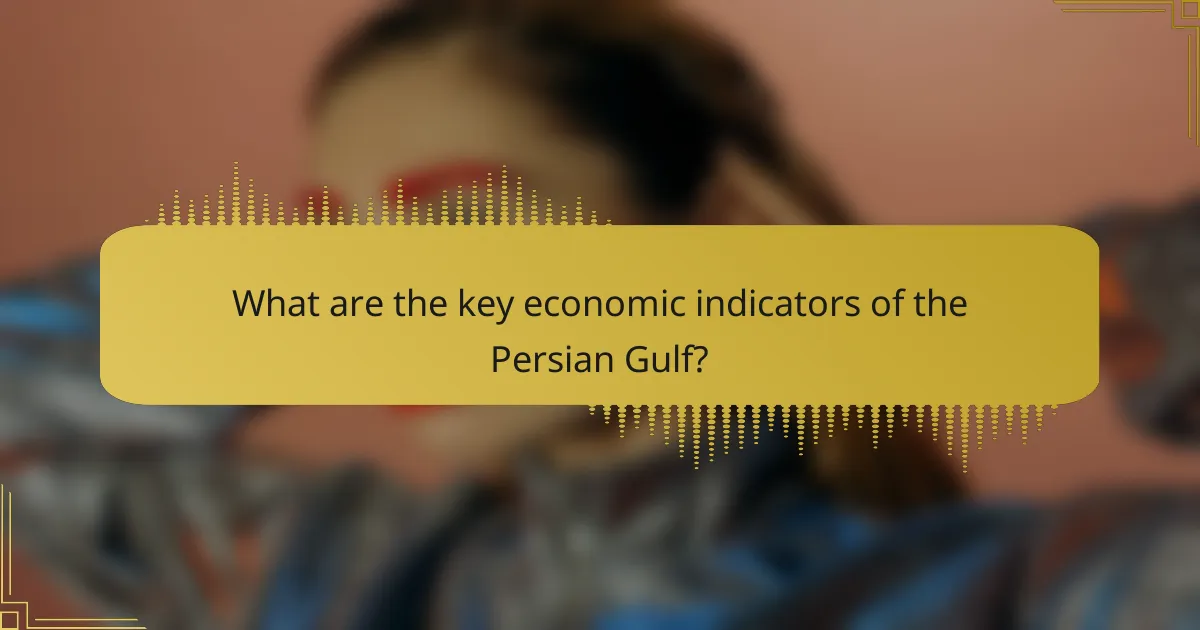The Persian Gulf stands out as a region of immense economic importance, primarily due to its substantial oil reserves and strategic shipping routes. In contrast, the Mediterranean region is celebrated for its rich historical legacy and diverse economies. This comparative analysis explores the distinct economic indicators, cultural influences, and geopolitical dynamics that define these two key regions, while also addressing the environmental challenges faced by the Persian Gulf.

How does the Persian Gulf compare to the Mediterranean region?
The Persian Gulf and the Mediterranean region differ significantly in terms of economic significance, cultural influences, and geopolitical dynamics. While the Persian Gulf is known for its vast oil reserves and strategic shipping routes, the Mediterranean boasts a rich historical legacy and diverse economies.
Economic significance
The Persian Gulf is a powerhouse of oil production, contributing a substantial portion of the world’s crude oil supply. Countries like Saudi Arabia, the UAE, and Kuwait have economies heavily reliant on oil exports, often leading to high GDP per capita figures.
In contrast, the Mediterranean region has a more varied economic landscape, with tourism, agriculture, and manufacturing playing significant roles. Countries such as Spain and Italy benefit from tourism revenues, while others like Greece rely on shipping and agriculture.
Cultural influences
The Persian Gulf is characterized by a blend of traditional Arab culture and modern influences, with a growing expatriate population contributing to its cultural diversity. Major cities like Dubai and Doha showcase a mix of Islamic traditions and contemporary lifestyles.
The Mediterranean region, on the other hand, is a melting pot of cultures, languages, and traditions, influenced by its long history of trade and conquest. This diversity is evident in its cuisine, art, and festivals, reflecting the rich heritage of countries like Greece, Turkey, and Italy.
Geopolitical dynamics
The geopolitical landscape of the Persian Gulf is marked by strategic alliances and tensions, particularly concerning oil resources and regional security. The presence of military bases and international interests often complicates relations among Gulf states.
In the Mediterranean, geopolitical dynamics are shaped by historical rivalries and current issues such as migration and trade. The region sees active involvement from the EU and NATO, influencing policies and cooperation among Mediterranean countries.

What are the key economic indicators of the Persian Gulf?
The Persian Gulf region is characterized by significant economic indicators, particularly in oil production, GDP growth, and trade volumes. These factors collectively illustrate the economic strength and global influence of the Gulf states.
Oil production levels
The Persian Gulf is one of the world’s leading regions for oil production, with countries like Saudi Arabia, Iraq, and the United Arab Emirates contributing substantially to global supply. Production levels can vary, but collectively, these nations often produce over 20 million barrels per day, accounting for a significant portion of the world’s oil output.
Oil production in the Gulf is influenced by OPEC regulations, geopolitical stability, and market demand. Countries in the region typically have vast reserves, allowing them to maintain high production levels even during fluctuations in global prices.
GDP growth rates
The GDP growth rates in the Persian Gulf vary by country but generally show robust performance, often exceeding global averages. For instance, nations like Qatar and the UAE have experienced growth rates in the range of 3-5% annually, driven largely by oil revenues and diversification into sectors like tourism and finance.
Economic diversification efforts are crucial for sustaining growth, especially as global energy markets evolve. Countries are increasingly investing in renewable energy and technology to reduce reliance on oil and ensure long-term economic stability.
Trade volumes
Trade volumes in the Persian Gulf are substantial, with the region serving as a key hub for both imports and exports. The Gulf Cooperation Council (GCC) countries engage in significant trade with Asia, Europe, and North America, with total trade often reaching hundreds of billions of USD annually.
Major exports include oil and gas, while imports consist of machinery, vehicles, and consumer goods. The strategic location of the Gulf enhances its role in global trade routes, making it a vital area for international commerce.

What are the environmental challenges in the Persian Gulf?
The Persian Gulf faces significant environmental challenges, primarily due to human activities and climate change. Key issues include marine pollution, climate change impacts, and habitat destruction, all of which threaten the delicate ecosystems in the region.
Marine pollution
Marine pollution in the Persian Gulf is a critical issue, largely driven by oil spills, industrial discharges, and agricultural runoff. The region’s heavy reliance on oil production contributes to frequent spills, which can devastate marine life and coastal habitats.
Additionally, untreated wastewater from urban areas and industries often enters the Gulf, leading to nutrient loading and harmful algal blooms. These blooms can deplete oxygen levels in the water, creating dead zones where aquatic life cannot survive.
Climate change impacts
Climate change significantly affects the Persian Gulf, with rising temperatures and sea levels posing serious threats. The region experiences extreme heat, which can impact marine species and coral reefs, making them more susceptible to bleaching.
Furthermore, increased evaporation rates and altered precipitation patterns can lead to water scarcity, affecting both human populations and ecosystems. Adaptation strategies are essential to mitigate these impacts, including sustainable water management and conservation efforts.
Habitat destruction
Habitat destruction in the Persian Gulf is primarily driven by coastal development, overfishing, and pollution. Urbanization along the coastline has led to the loss of vital habitats such as mangroves and seagrass beds, which serve as nurseries for many marine species.
Overfishing practices further exacerbate the situation, depleting fish stocks and disrupting the ecological balance. Protecting these habitats through marine protected areas and sustainable fishing practices is crucial for preserving biodiversity in the Gulf.

How does the Persian Gulf’s tourism sector compare to the Caribbean?
The Persian Gulf’s tourism sector is distinct from the Caribbean in terms of visitor demographics, infrastructure, and attractions. While both regions attract millions of tourists, the Persian Gulf focuses more on luxury and business travel, whereas the Caribbean is known for its leisure and beach-oriented tourism.
Visitor statistics
The Persian Gulf sees a diverse range of visitors, with millions arriving annually, particularly from neighboring countries and Europe. In contrast, the Caribbean typically attracts a higher percentage of North American tourists, with annual arrivals often exceeding 30 million.
Both regions have experienced fluctuations in visitor numbers due to global events, but the Persian Gulf has shown resilience with its growing appeal for business and luxury travel, while the Caribbean remains a top choice for vacationers seeking sun and relaxation.
Tourism infrastructure
The Persian Gulf boasts modern and extensive tourism infrastructure, including luxury hotels, shopping malls, and state-of-the-art airports. Cities like Dubai and Doha are known for their high-end accommodations and facilities that cater to both leisure and business travelers.
In comparison, the Caribbean has a more varied infrastructure, with some islands offering luxury resorts while others focus on budget-friendly options. Accessibility can vary significantly, with larger islands having better transport links than smaller ones.
Attractions and activities
The Persian Gulf offers unique attractions such as futuristic architecture, desert adventures, and cultural experiences in cities like Abu Dhabi and Dubai. Activities range from shopping in lavish malls to exploring historical sites and enjoying water sports.
The Caribbean, on the other hand, is famous for its stunning beaches, vibrant nightlife, and outdoor activities like snorkeling and diving. Each island has its own charm, with options for eco-tourism, cultural festivals, and culinary experiences that highlight local flavors.

What are the historical contexts of the Persian Gulf and Red Sea?
The historical contexts of the Persian Gulf and Red Sea are shaped by their strategic locations and the civilizations that have thrived around them. Both regions have served as vital maritime routes for trade, cultural exchanges, and colonial endeavors throughout history.
Trade routes
The Persian Gulf has long been a crucial trade route connecting the Middle East with Asia and Europe, facilitating the exchange of goods such as oil, spices, and textiles. In contrast, the Red Sea has historically linked Europe to Asia via the Suez Canal, enhancing trade in commodities like coffee, gold, and ivory.
Today, both regions remain significant for global shipping, with the Persian Gulf being a major conduit for oil exports and the Red Sea serving as a key passage for international maritime traffic. Understanding these trade routes is essential for grasping the economic dynamics of the areas.
Cultural exchanges
Cultural exchanges in the Persian Gulf and Red Sea regions have been influenced by their diverse populations and historical interactions. The Persian Gulf has seen a blend of Arab, Persian, and Indian cultures, leading to a rich tapestry of traditions, languages, and cuisines.
Similarly, the Red Sea has facilitated cultural interactions between African, Arabian, and Asian societies, resulting in shared customs, art forms, and religious practices. These exchanges have shaped the identities of the communities surrounding both bodies of water.
Colonial influences
Colonial influences have significantly impacted the historical contexts of both the Persian Gulf and Red Sea. The Persian Gulf experienced British and later American involvement, which shaped its political landscape and economic structures, particularly in the oil sector.
In the Red Sea region, European powers, especially the British and French, established control over key ports and trade routes, influencing local governance and trade practices. These colonial legacies continue to affect the geopolitical dynamics in both regions today.

What are the geopolitical tensions in the Persian Gulf?
The Persian Gulf is marked by significant geopolitical tensions primarily driven by territorial disputes, sectarian divides, and competition for regional influence. Key players include Iran, Saudi Arabia, and the United States, each pursuing their strategic interests, which often leads to conflicts and instability in the region.
Regional conflicts
Regional conflicts in the Persian Gulf often stem from historical rivalries and differing political ideologies. The ongoing tensions between Iran and Saudi Arabia exemplify this, as both nations vie for dominance in the region, influencing conflicts in neighboring countries such as Yemen and Syria.
Additionally, the presence of foreign military forces, particularly from the United States, complicates the dynamics. These forces are often seen as a stabilizing factor by some nations, while others view them as an infringement on sovereignty, further escalating tensions.
To navigate these conflicts, it is crucial to understand the underlying issues, such as sectarianism and resource competition. Engaging in diplomatic dialogue and fostering regional cooperation can help mitigate tensions and promote stability in the Persian Gulf.
